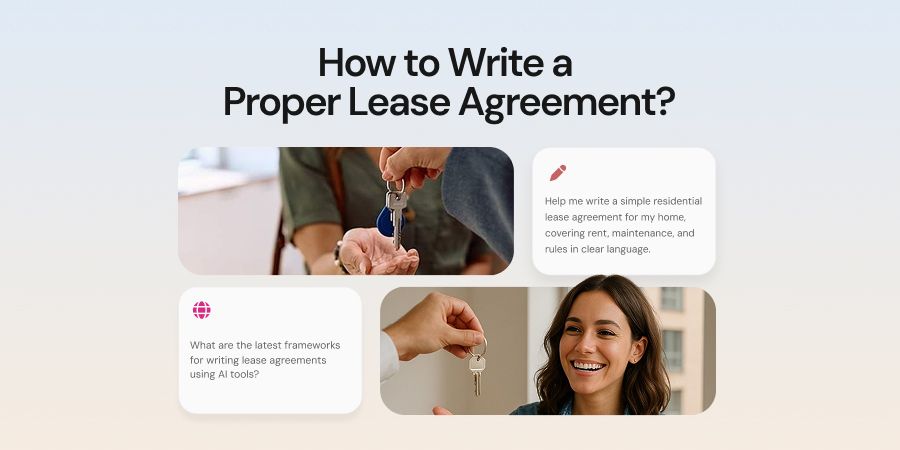
How to Write a Proper Lease Agreement?
A lease agreement is the backbone of any rental relationship.
It protects both landlords and tenants by defining rights, responsibilities, and clear expectations. Without a detailed rental agreement, disputes over rent, deposits, or property use can surface quickly.
With a lease agreement in place, every party knows their role and responsibilities, and that clarity saves time, money, and stress.
This guide covers everything you need to know about creating a rental lease agreement. You’ll learn how to draft a simple lease agreement, the difference between lease types, what disclosures to include, and even see a rental agreement sample and lease agreement template to guide your own.
Why a Lease Agreement Is Important
A residential lease agreement is more than just a formality. It functions as a safeguard for both parties:
-
Prevents Disputes: Sets rent amounts, due dates, and rules in writing.
-
Defines Obligations: Outlines maintenance, utility, and property care responsibilities.
-
Establishes Compliance: Keeps landlords aligned with local landlord-tenant laws.
-
Creates Trust: Tenants feel more secure when rules are documented clearly.
A rental agreement template ensures that you don’t miss critical details. Over time, it also makes managing multiple properties easier because you can update the same structure rather than drafting from scratch.
For comparison, think of it as writing any other formal document—similar to preparing a press communique or a case report. Structure brings credibility and consistency.
The Leasing Process Step by Step
Creating a rental lease agreement usually comes after a few important steps:
-
Market Your Rental Property
Write a strong listing highlighting the home’s best features. Include at least 10 high-quality photos. A well-written rental ad works much like an introduction paragraph in writing – clear, concise, and attention-grabbing. See tips on clarity in this guide to writing introductions.
-
Host Showings
Allow prospective tenants to view the property. In-person tours or virtual open houses help set expectations before paperwork begins.
-
Review Rental Applications
Applications reveal history, income, and references. Use them to filter for responsible tenants.
-
Run Credit and Background Checks
Screening tenants is essential. It confirms their financial stability and provides insight into previous housing history.
-
Contact Past Landlords
A simple phone call or email can confirm payment habits and property care.
By the time you reach the point of creating a house rental agreement, you already know you’re dealing with a qualified tenant. That makes the lease a binding document rather than just another formality.
Landlord-Tenant Laws by State
Every rental lease agreement must comply with local landlord-tenant laws. These rules differ across states and can affect:
-
Rent collection and the increases.
-
Renewal or termination notices.
-
Security deposit limits.
-
Eviction procedures.
-
Required disclosures and addenda.
For example, California regulates rent control more heavily than states like Texas. Oregon treats “last month’s rent” similar to a deposit, requiring special handling. Always consult your state-specific landlord-tenant laws before finalizing your rental agreement form.
Think of this step as fact-checking when writing a journalistic article – accuracy matters because it protects you legally.
Lease Types You Can Choose
Not all lease agreements look the same. The type you choose depends on your property, tenant needs, and your own flexibility as a landlord.
-
Fixed-Term Lease
A residential lease agreement with a set end date, usually six months or one year. Predictable for both landlord and tenant.
-
Month-to-Month Lease
A rental agreement template that automatically renews monthly until either party ends it with proper notice. Flexible but less stable.
-
Simple Lease Agreement
A short and straightforward house rental agreement that covers essentials only. Often used for smaller rentals or temporary arrangements.
When creating a sample lease agreement, consider whether you value long-term security (fixed-term) or flexibility (month-to-month).
Required Disclosure Attachments in a Lease Agreement
Many states require that you include disclosures alongside your lease agreement template. These attachments provide transparency and protect both parties. Common disclosures include:
-
Lead Paint Disclosure – Mandatory for homes built before 1978.
-
Mold Disclosure – Required in many states to warn tenants about risks.
-
Other State Requirements – Some states even require voter registration forms or radon disclosures.
Adding these is not optional. Skipping them can invalidate your rental lease agreement. Treat them like appendices in academic writing – much like adding references in a literature review, they provide the necessary context.
Security Deposits in a Lease Agreement
A security deposit is standard in almost every residential lease agreement. It protects the landlord if the tenant damages the property or fails to pay rent. Rules vary by state, but most regulate:
-
Maximum deposit amount – Some states cap it at one month’s rent.
-
How deposits are stored – Separate accounts or interest-bearing accounts may be required.
-
Return timelines – Typically within 14–30 days after move-out.
Your rental agreement form should clearly state:
-
The exact deposit amount.
-
How it will be held.
-
The timeline for returning funds.
Rental Agreement Sample: Security Deposit Clause
“Tenant shall pay a security deposit of $1,200 prior to move-in. Deposit will be held in a separate account and returned within 30 days of lease termination, less any deductions for damages beyond normal wear and tear.”
Collecting Last Month’s Rent
Alongside a deposit, landlords may collect the last month’s rent upfront. This provides security if a tenant leaves without paying the final month. Some states (like Oregon) treat it like a security deposit, meaning it must be held in a separate account.
Sample Lease Agreement: Last Month’s Rent
“Tenant agrees to prepay the final month’s rent of $1,200. Funds will be held in accordance with state regulations and applied to the last month of tenancy.”
Always confirm state-specific rules before adding this clause to your house rental agreement.
How to Create a Lease Agreement: Step by Step Process
Here are key simple steps which you can follow to create a lease agreement yourself.
1. Collect Party Information
Your rental lease agreement should include:
-
Landlord’s full name, contact info, and address for notices.
-
Tenant(s) full names and contact info.
-
Any co-owners or property managers.
-
Additional occupants (children, relatives, etc.) to document who resides in the home.
2. Describe the Property
State the full property address and type (single-family, apartment, condo). List any appliances, fixtures, or furniture included. Mention known defects.
Example: “This lease agreement covers the premises at 245 Elm Street, Springfield. Included appliances: refrigerator, stove, and dishwasher.”
3. Define Utilities and Services
Specify which utilities are included in rent and which the tenant pays. Be clear about billing schedules.
Rental Agreement Template Example: “Tenant shall be responsible for electricity, internet, and gas. Landlord will cover water, sewer, trash removal, and lawn maintenance.”
4. State Lease Terms
Define whether it is a fixed-term or month-to-month lease agreement. Include start and end dates. Add termination and renewal rules.
Example: “This simple lease agreement begins on June 1, 2025, and ends on May 31, 2026. Lease shall renew month-to-month unless terminated with 30 days’ written notice.”
5. Set Monthly Rent and Due Dates
Detail the monthly rent, first payment date, and proration rules if the tenant moves in mid-month.
Sample Lease Clause: “Rent is $1,200 due on the 1st of each month. For move-ins after the 15th, rent will be prorated.”
6. Add Additional Fees
A strong rental agreement template should outline every possible fee. Common examples:
-
Late fees for overdue rent.
-
Pet fees (monthly or one-time).
-
Insufficient fund (NSF) fees.
Sample Lease Clause: “Tenant agrees to a late fee of $50 if rent is not received within 5 days of the due date. Pet rent of $25 per month applies for each approved pet.”
7. Set Payment Methods
State acceptable ways tenants can pay. A simple lease agreement should include whether you accept:
-
Online payments.
-
Checks.
-
Money orders.
Example: “Tenant may pay rent via electronic transfer, personal check, or money order. Cash payments are not accepted.”
8. Define Rights and Obligations
Every rental lease agreement should balance responsibilities:
-
Tenant obligations may include:
-
Using the property for residential purposes only.
-
Keeping the property in good condition.
-
Notifying the landlord of needed repairs.
-
-
Landlord obligations may include:
-
Maintaining common areas.
-
Making timely repairs.
-
Respecting tenant privacy.
-
Rental Agreement Sample Language: “Landlord shall provide timely repairs and maintain utilities as required by law. Tenant agrees to maintain cleanliness of the premises and notify landlord of any major damage immediately.”
9. Require Renter’s Insurance
Many landlords now require tenants to carry renter’s insurance. A lease agreement template can specify minimum coverage.
Example: “Tenant must maintain renter’s insurance with a minimum liability coverage of $100,000. Proof of insurance must be provided before occupancy.”
10. Add Property Rules
Rules create clarity and prevent disputes. These may include:
-
Condo or HOA regulations.
-
Rules for modifications (e.g., painting walls).
-
Safety policies (e.g., weight limits on balconies).
-
Maintenance duties (trash, lawn care, snow removal).
11. Establish Policies for Pets, Smoking, Parking, and Storage
Cover lifestyle areas in your house rental agreement to avoid confusion later:
-
Pets: Are they allowed? If yes, outline pet rent, deposits, and breed restrictions.
-
Smoking: State if smoking is allowed indoors, outdoors, or prohibited.
-
Parking: Define assigned spaces or open parking rules.
-
Storage: Clarify if storage is available and any additional costs.
Sample Lease Agreement Clause: “Tenant may keep one cat or one dog under 40 lbs with landlord approval. Pet rent is $25 per month. Smoking is prohibited inside the unit. Tenant is assigned one parking space at no additional cost.”
12. Review the Lease Agreement
Before sharing with tenants, review every clause. Ensure state laws are followed and all disclosures are attached. Save a draft and adjust if needed.
Think of this step as editing a structured piece of writing – just like revising a memoir or a speech, precision and flow matter.
13. Sign the Lease Agreement
Digital tools allow both landlord and tenant to sign online. Once signed, the rental agreement form becomes legally binding.
Steps to finalize:
-
Send to tenant for digital signature.
-
Review any comments or requests.
-
Countersign as the landlord.
-
Save a copy in your records.
Sample Lease Signing Note: “This lease agreement shall be effective once signed by both landlord and tenant. A signed copy will be provided to each party for their records.”
Best Practices for Writing a Lease Agreement
A lease agreement works best when it is detailed yet easy to read. Follow these practices to ensure your document protects both landlord and tenant:
-
Use plain, direct language. Avoid legal jargon where possible.
-
Be specific about money, dates, and rules.
-
Update your rental agreement template when local laws change.
-
Keep signed copies stored securely, both digitally and on paper.
-
Include all disclosures, even if you think they’re obvious.
Clarity is key. A lease should function like well-written minutes of a meeting – just as you would in a meeting notes guide, every detail must be captured to avoid confusion later.
Sample Lease Agreement Template
Below is a simplified structure you can use as a sample lease agreement. Adapt it to your property and state laws.
Residential Lease Agreement
This rental agreement form (“Agreement”) is made on [Date] between:
-
Landlord: [Full Name, Address, Contact Information]
-
Tenant(s): [Full Names of All Tenants]
1. Property Address
[Full property address, unit number if applicable]
2. Lease Term
Start Date: [MM/DD/YYYY]
End Date: [MM/DD/YYYY]
3. Rent
Monthly Rent: $[Amount]
Due Date: [Day of each month]
Payment Method: [Online transfer, check, money order]
4. Security Deposit
Amount: $[Amount]
Held in: [Bank/Account per state law]
Return: Within [X days] of lease termination, less allowable deductions.
5. Utilities
Landlord pays: [List utilities]
Tenant pays: [List utilities]
6. Rules & Policies
-
Smoking: [Allowed/Not allowed]
-
Pets: [Allowed/Not allowed; include pet rent/deposit if applicable]
-
Parking: [Details]
-
Storage: [Details]
7. Obligations
Tenant must: Maintain property, notify landlord of damage, pay rent on time.
Landlord must: Provide timely repairs, maintain utilities and services required by law.
8. Renter’s Insurance
Tenant must provide proof of renter’s insurance with minimum liability coverage of $[Amount].
9. Termination
Notice required: [30/60 days] before move-out.
10. Signatures
Tenant Signature: _____________________ Date: _______
Landlord Signature: ___________________ Date: _______
This rental agreement sample offers a clear, adaptable framework.
For more creative templates, you can explore how structure guides clarity in areas like writing cover letters with no experience or even in writing a news release.
Closing Thoughts
A rental lease agreement is the foundation of every landlord-tenant relationship. By documenting property details, payments, rules, and obligations, you reduce risk and create trust. Using a simple lease agreement or a detailed house rental agreement depends on your needs, but the essentials should never be skipped.
Digital platforms make this process faster. With an editable rental agreement template, you can create, review, and sign leases online, without missing critical details. Treat your lease as a living document: clear, updated, and protective of everyone involved.
Disclaimer: This guide is for informational purposes only. Laws change frequently, and requirements differ by state. Always verify details with a licensed attorney before using any lease agreement template or rental agreement sample.
Frequently Asked Questions
Here are a few frequently asked questions related to writing a lease agreement.
More topics you may like

How to Write an Introductory Paragraph: Structure, Examples, and Tips

Muhammad Bin Habib

How to Write a One-Page Literature Review in 2025

Muhammad Bin Habib

How to Write a Case Report in 2025

Muhammad Bin Habib

How to Write a Cover Letter with No Experience Using AI Chat

Muhammad Bin Habib

How to Write a Journalistic Article: Definition, Types, Structure and More

Muhammad Bin Habib
